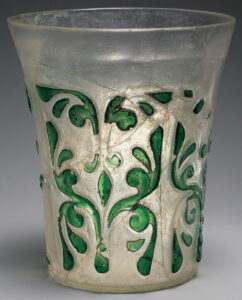
LNS 1407 G
Glass beaker, colorless body, cameo-cut transparent green in a repeating vegetal pattern
Glass objects in the collection date back almost 4,500 years and include objects from virtually every period since. The depth of the glass objects in The al-Sabah Collection allows both scholars and visitors to study, understand and appreciate the evolution of glass techniques from the Bronze Age to 19th century CE.
A stellar example of early glass work can be found on an Achaemenid colourless glass bowl from the late 6th to 5th centuries BCE. The relief-cut rosette, leaf and lotus bud design provides a hint of work to come, presenting a motif that would appear in glass objects even millennia away.
The glassmakers of the Islamic Mediterranean and Iranian regions inherited a rich tradition of techniques and types from their forebears that they were to take in new directions in the mediaeval period.
In Iran the cutting of glass on abrasive wheels continued uninterrupted from the Sasanian period until the 11th century AD. Large numbers of blown glass vessels survive from the earliest period up to the 15th century AD; many of these were blown into metal or ceramic moulds to produce elegant shapes with integral surface decoration..
From the 13th century the glass makers of Syria and Egypt developed a new technique for painting on plain glass vessels. This new type of glass decoration was initially used to produce figural scenes; later a robust calligraphic style was developed, where the entire surface decoration of the likes of mosque lamps and vases is dominated by prominent inscriptions, often further embellished with surface gilding, a style that had never before been seen in glass.

Glass beaker, colorless body, cameo-cut transparent green in a repeating vegetal pattern
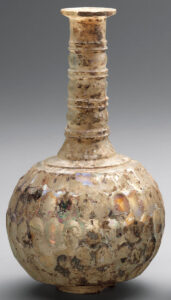
Glass bottle, the entire surface cut, the body with concave facets in hexagonal pattern
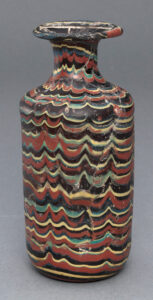
Glass bottle, transparent purple body with trailed and marvered pattern in opaque red and yellow and translucent blue and turquoise (the green colour resulting from
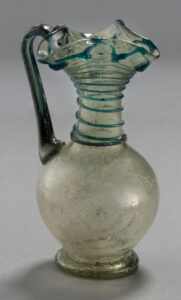
Glass pitcher with trilobed mouth, handle and decorative ‘trails’ in contrasting color
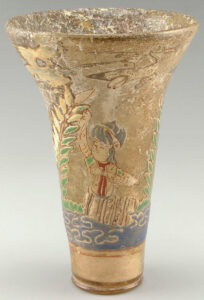
Glass beaker, with two turbanned men seemingly fowling amidst flying geese and vegetation surrounding a body of water
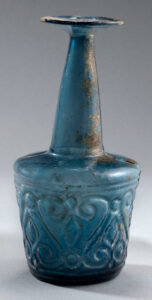
Glass bottle with conical neck and widely flaring rim (so-called ‘mallet bottle’ shape), the body with a relief design of counterchanging deltoid compartments, each containing
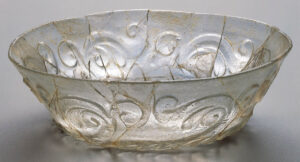
Glass bowl, exterior slant-cut in relief, the walls with a series of large ‘fleshy’ half-palmettes. Filling the bottom, is a winged senmurv-like creature, the head
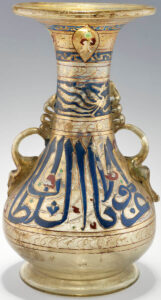
Enamelled glass ‘vase’ featuring two Chinese-style phoenixes and a large thuluth inscription exclaiming ‘Glory to our Lord the Sultan, the King, the Learned’
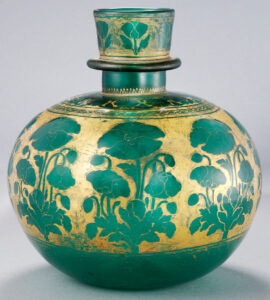
Glass huqqa reservoir, transparent middle green, the body decorated with a row of flowering plants reserved on a field of gold
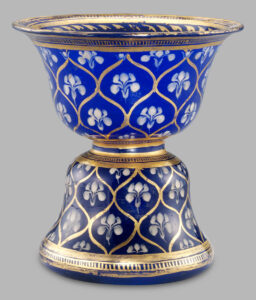
Glass spittoon with bell-shaped base and reservoir, decorated with iris heads inside the compartments of an ogive pattern
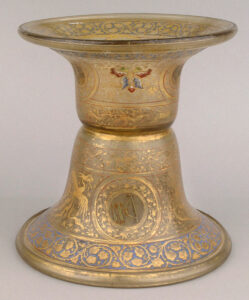
Enamelled glass stand featuring a Mamluk princely blazon of courtly office (bow and two arrows, for a bunduqdar, or Keeper of the Bow), with Chinese-style
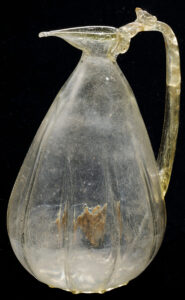
Colourless glass ewer with elongated horizontal spout, the foot moulded in the form of a rosette
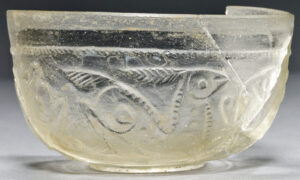
Fragmentary glass cup relief-cut with pairs of confronted hares and a mythical quadruped
Subscribe to news about Dar al-Athar al-Islamiyyah and The al-Sabah Collection, Exhibitions, Courses and Events